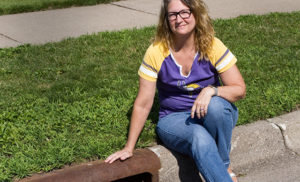By MARGIE O’LOUGHLIN
 Anyone who has walked or biked around Como Lake this summer has got to wonder, “What is that smell?”
Anyone who has walked or biked around Como Lake this summer has got to wonder, “What is that smell?”
The short answer is decomposing curly-leaf pondweed.
The long answer is more complicated.
At Capitol Region Watershed District (CRWD), Water Resource Project Manager Britta Belden described the life cycle of this invasive aquatic species, and why it causes such a problem in Como Lake.
She said, “Curly-leaf pondweed was first observed here in the early 1990s, and it now dominates the aquatic plant eco-system – with nearly 100% coverage by early June. It has done so well because Como Lake is a shallow lake with a maximum depth of 15’. Curly-leaf pondweed starts growing in late fall, from seedlings dropped in June. It continues growing through the winter beneath the ice, which gives it a competitive advantage.”
“When the ice goes out and sunlight hits the water in April, these plants really take off and grow rapidly.”
~ Britta Belden
She continued, “Curly-leaf pondweed forms thick mats of vegetation on the lake surface in the spring, and then quickly dies off in late June. This coincides with peak sunlight and high summer temperatures, providing perfect conditions for rapid decomposition – and that’s what people are smelling.”
Despite continued attempts to improve the water quality of Como Lake, its phosphorous levels are about three times higher than the state standards for shallow lakes. Once the curly-leaf pondweed starts to die, it releases a burst of phosphorous back into the water and, in a predictable cycle, is followed by a major algae bloom.
Phosphorous is not only present in Como Lake because of decomposition, it’s also being transported in runoff to the lake.
To address this problem, CRWD invests in projects and partnerships that reduce nutrients and other pollutants in watershed runoff. In one such partnership, CRWD supports a neighborhood group called the Como Active Citizen Network; their Como Curb Clean-Up is a coordinated effort to remove leaves and other organic material from neighborhood streets for six weeks in the fall.
This program has about 100 participants – all of them committed to improving the water quality of Como Lake through this practice.
Janna Caywood is a founding member of the Como Active Citizen Network, and a Como resident for more than 20 years. She said, “We’re a group of neighbors who care about our nearby lake.
“We’re not the leaf police but we believe that, as property owners, we have the ability to impact our neighborhood positively. By keeping the curbs and gutters clean in front of our houses, we can prevent additional phosphorous from getting into Como Lake through run-off.”
“Many people mistakenly believe that phosphorous in commercial lawn fertilizers is the culprit, but it’s decaying organic matter (leaves and grass clippings) that really throw Como Lake out of balance.”
~ Janna Caywood
Part of the problem is that Como Lake is being asked to do more than it realistically can. Caywood explained that there are no longer any natural tributaries delivering fresh water to the 70 acre lake. She said, “With 22 storm sewers draining into such a small lake, it has essentially become a glorified storm water basin. Yet, because of its location, we expect it to perform as a recreational amenity – and a natural amenity, too.”
Caywood said, “This kind of ‘non-source’ pollution is the hardest to address, because it’s coming from St. Paul, Roseville, and Falcon Heights through the storm water system. We see this as a great challenge for our generation, figuring out how to deal responsibly with the impact of human living on our waters.”
Looking ahead, the Capitol Region Watershed District will begin implementing new management strategies for Como Lake next year. Its 20-year Como Lake Management Plan contains 54 actions designed to improve the health of this much-loved neighborhood gathering spot. To better understand Como Lake both past and present, follow the link below to view a story map developed by the Capitol Region Watershed District. www.capitolregionwd.org/comolake
“Minnesota has a great responsibility for managing its lakes wisely. As a state, we are second only to Alaska in the amount of surface water that we have.”
~ Janna Caywood, Como Active Citizen Network
Comments
No comments on this item Please log in to comment by clicking here